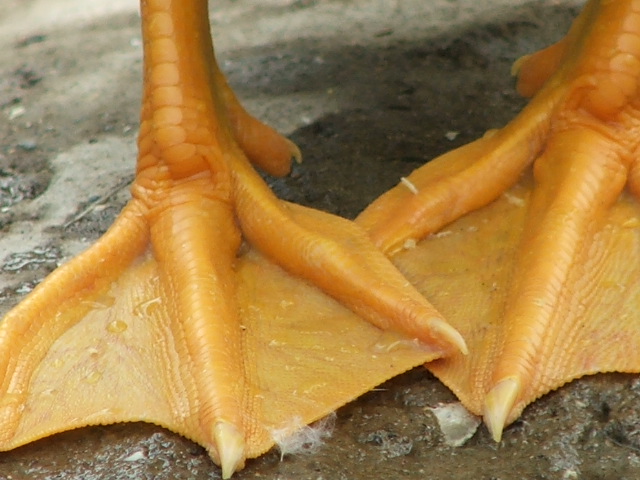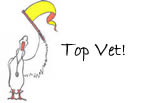|
Splinting Duck
and Goose Legs
We
receive quite a few disturbing emails that begin: “Can you tell me
how to splint my duck’s leg…”

When a duck or goose
breaks their leg, qualified veterinary assistance is always in
immediate order. Do not try to splint your bird’s leg in lieu of
seeking out a qualified vet to do the procedure properly.
We have received
emails from folks boasting that they saved the day with a few
ordinary popsicle sticks and some gauze tape, but whenever we have
asked them to produce a photo of the duck after the splint was
removed, communications from their end always came to a screeching
halt. Apparently, the final result was not as pretty or perfect as
boasters would have liked us to believe.
You can cause serious
injury and further discomfort to an animal when trying to remedy a
problem without proper equipment, tools and information. Your vet
has all of these things on hand, so please leave this to the
professionals.
X-rays need to be
done, and fractured bones may need to be reset before splints or
casts are administered. A qualified waterfowl vet must do this
procedure to prevent infection, lameness or even death. Anesthesia
and pain relievers will most likely be needed to help alleviate the
trauma and pain your stressed feathered friend is experiencing.
Expanding Our Waterfowl
Vet Directory
 Please
take a moment to visit our
Waterfowl Vet Finder and check
the vet listings for your state. This is a resource available to
assist you and your flock. Please
take a moment to visit our
Waterfowl Vet Finder and check
the vet listings for your state. This is a resource available to
assist you and your flock.
If you have a
waterfowl vet and they are not listed here, please fill out the form
to add them to our list. As many of you know, it can be very
difficult to find a waterfowl vet in your vicinity. By adding your
waterfowl vet to our directory you do a great service to others in
your area interested in the quality care of their flock.
We are looking for
volunteers for our Waterfowl Vet Finder Directory Expansion Team. If
you live in a state other than CT, RI, MA, ME, NH or NY you can
volunteer your time and phone line to call on avian vets in your own
state (phone lists will be provided to you). Volunteers confirm
which avian vets handle waterfowl and get their verbal permission to
be added to our website directory. This is a great way to help ducks
and geese right in your own state! If you are interested in helping
build our directory, please fill out our
Online Volunteer Form and
check the box to join our Waterfowl Vet Finder Directory Expansion
Team.
Keeping Waterfowl Cool in
Summer:
The Autumn Olive Tree (Elaeagnus umbellata)
Some
folks don’t care for the Autumn Olive tree since it has escaped
cultivation and progressively invades natural areas, but Majestic
highly recommends this shade tree for your waterfowl.
One of the great
things about this tree is you can prune it to your heart’s content
in any season with little risk of killing it. In fact, it tends to
grow back even stronger after a pruning. We enjoy shaping the fast
growing trees that naturally dot our landscape. They are easy to
transplant and they make nice shady spots in our waterfowl pens. It
is simple to control their height and shape, so you can sculpt them
to fit into nearly any size pen or yard.
The Autumn Olive
thrives in full sun and it enriches the soil with nitrogen. It
flowers in spring and smells amazing. In the fall, the thick bunches
of non-toxic berries attract wild birds into your yard.
Avoiding Toxic Plants
We
have received many requests for information on toxic plants. The
ASPCA Animal Poison Control Center has a very helpful list with
photographs to help you ensure that your duck and goose pens are
safe from many kinds of toxic flowers, plants, shrubs and trees.
Please visit their website to view the
List of Toxic Plants.
Some signs that your
waterfowl may have ingested something toxic include:
- Diarrhea
- Vomiting
- Drooping neck,
wings
- Weakness
- Seizures,
Tremors, Convulsing, Shivering
- Irritation
around eyes or bill
- Depression
- Hyperventilation
- Loss of appetite
If any of your flock
members exhibit any of these traits, please consult your
veterinarian immediately.
Keeping Ponds and Pools
Clean
It
is important to keep kiddy pools and ponds clean, either by
filtration or the old fashioned empty & fill routine. Botulism is a
deadly threat and it brews easily in warm, stagnant or unclean
water. Avoid unnecessary risks; do not throw food into your ponds.
Uneaten portions sink to the bottom and may grow the type of
bacteria you are trying to avoid in your healthy waterfowl
environment.
|